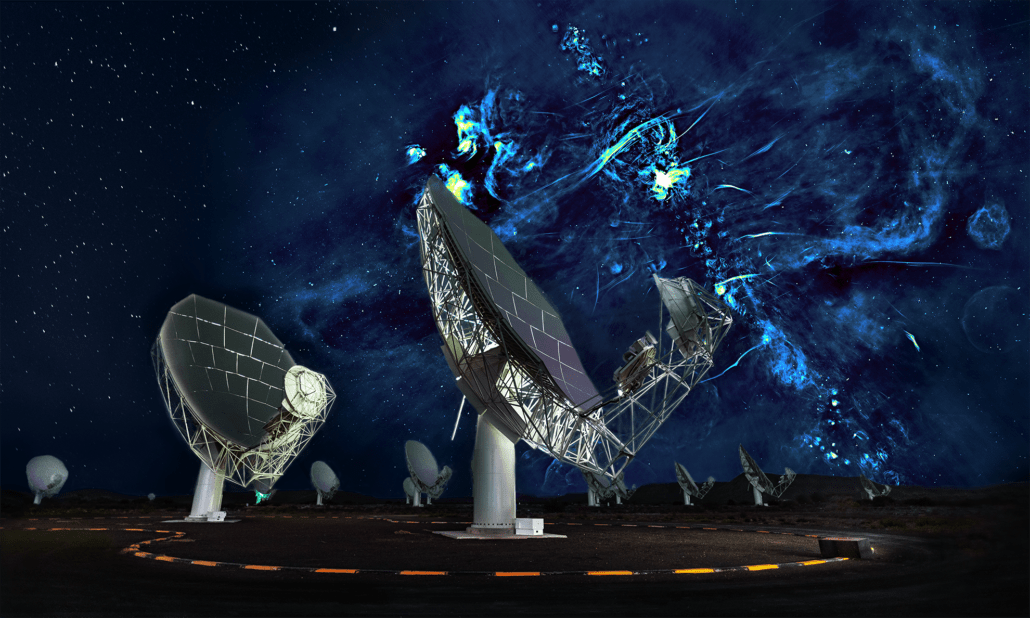Several million years ago, the core of our galaxy experienced a powerful event. It blew out a huge bi-lobed bubble that blasted through the interstellar medium in two directions. Whatever it was, it released huge amounts of energy from the central supermassive black hole, Sagittarius A* (Sgr A* for short).
These bubbles contain weird, spindly one-dimensional vertical filaments that emit radio signals of their own. In 1984, astronomer Farhad Yusef-Zadeh at Northwestern University and his collaborators were the first to observe these wispy trails. Now, they know of more than a thousand of them. They give off radio waves in the microwave portion of the electromagnetic spectrum.

Wait, There’s More!
Recently, the team found a smaller population of filaments near Sgr A*. However, these aren’t vertical. Instead, they lie along the galactic plane and radiate away like spokes on a wheel. “It was a surprise to suddenly find a new population of structures that seem to be pointing in the direction of the black hole,” Yusef-Zadeh said. “We have always been thinking about vertical filaments and their origin. I’m used to them being vertical. I never considered there might be others along the plane.”
He and the team were stunned when they saw these radially stretched structures. “We had to do a lot of work to establish that we weren’t fooling ourselves,” he said. “And we found that these filaments are not random but appear to be tied to the outflow of our black hole. By studying them, we could learn more about the black hole’s spin and accretion disk orientation. It is satisfying when one finds order in a middle of a chaotic field of the nucleus of our galaxy.”
Yusef-Zadeh pointed out that something clearly occurred in the core to create the short radial filaments. “We think they must have originated with some kind of outflow from an activity that happened a few million years ago,” he said. “It seems to be the result of an interaction of that outflowing material with objects near it.”

Pinning Down Filament Histories
Like other supermassive black holes, Sgr A* has been known to swallow up material occasionally. Then, it “burps out” an energetic, highly magnetized blast of energy and plasma. That seems the most likely explanation for the appearance of the bubbles and filaments. It’s possible that such a jet collided with clouds of gas and dust in the immediate neighborhood. It could have led to twisted magnetic structures that form the filaments.
Another idea is that molecular gas got stretched by the expansion of the material near the core. That somehow creates the radial filaments. Such action would also explain the lopsided appearance of the Sgr E complex. It lies to one side of the black hole at the intersection of the central molecular zone and a wide central dust lane. Finally, it’s also possible that the gravitational potential of our galaxy’s central bar is tugging the Sgr E cloud. That could play a role in forming those filaments.

The vertical ones pose a different challenge to understand. They tower up to 150 light-years above the plane of the galaxy. Yusef-Zadeh and his team suggest a couple of ideas for their existence. The first is cosmic-ray pressure forcing filaments into a vertical orientation. That pressure is the aftermath of the explosive event a few million years ago that created the bubbles.
Some verticals could be the result of the interaction of a large-scale wind in the region and obstacles embedded within the flow. That combination creates filaments by wrapping the wind’s magnetic field around the obstacles. Clearly, there’s a lot of observation work and analysis to be done in order to really understand what’s happening to create both sets of filaments.
Different Types of Filaments, Milky-Way Style
Their origins likely explain the radically different orientations and characteristics of each filament population. The vertical filaments are perpendicular to the plane of the galaxy and stretch up to around 150 light-years in length, while the horizontal ones are parallel to the plane and are only about 5 to 10 light-years long. The horizontals point radially toward the center of the galaxy where Sgr A* lies. The vertical ones are magnetic and relativistic (meaning their particles are moving near the speed of light). The horizontal filaments appear to emit thermal (warm) radiation and seem to be accelerating warmed material in a molecular cloud. There are just a few hundred of these horizontal filaments seen so far.
The vertical filaments appear around the nucleus of the galaxy while the horizontal ones spread out to only one side. According to Yusef-Zadeh, the radial outflows are somewhat lopsided. That may give some clues about the black hole region itself. “One of the most important implications of radial outflow that we have detected is the orientation of the accretion disk and the jet-driven outflow from Sagittarius A* along the galactic plane,” he said.
Looking at the Filaments through Time
While the radial filaments Yusef-Zadeh and his team found are a more recent discovery, the vertical ones are old friends. There are nearly a thousand of them grouped in pairs and clusters. Yusef-Zadeh says they are about 6 million years old.
He’s been studying odd structures in the galactic core for decades. In 1984, he worked with astronomers Mark Morris and Don Chance to make a Very Large Array radio map of the galactic center in the 20-cm wavelength band when they first found the vertical structures. The emissions they detected came from nonthermally emitting (i.e. cool) gas arranged along magnetic structures.
Later on, in 2019, Yusef-Zadeh was part of a team led by astronomer Ian Haywood (University of Oxford) that used the MeerKAT radio observatory facility in South Africa to discover two gigantic radio-emitting bubbles near Sgr A*. That huge burst of energetic activity described earlier created those bubbles several million years ago.
At the time, the team immediately suspected Sgr A* as a source of the hourglass-shaped structure. “The center of our galaxy is relatively calm when compared to other galaxies with very active central black holes,” said Heywood. “Even so, the Milky Way’s central black hole can—from time to time—become uncharacteristically active, flaring up as it periodically devours massive clumps of dust and gas. It’s possible that one such feeding frenzy triggered powerful outbursts that inflated this previously unseen feature.”
MeerKAT Scans the Bubbles
The discovery of radio bubbles in the galactic core a few years ago highlighted the great capabilities of the MeerKAT radio telescope. It’s an array of 64 radio dishes sensitive to emissions in the microwave regime, ranging from wavelengths between 3 to 30 centimeters. Yusef-Zadeh credits the facility with helping his team to pinpoint the filaments against a busy background of other emitters. They used a technique to remove the background and smooth the noise from MeerKAT images in order to isolate the filaments from surrounding structures.
“The new MeerKAT observations have been a game changer,” he said. “The advancement of technology and dedicated observing time have given us new information. It’s really a technical achievement from radio astronomers.”
For More Information
Mysterious dashes revealed in Milky Way’s Center
The Population of the Galactic Center Filaments: Position Angle Distribution Reveals a Degree-scale Collimated Outflow from Sgr A* along the Galactic Plane
Giant balloon-like structures discovered at Center of Milky Way
MeerKAT Radio Telescope


